"Circular saw" Sergeant Grevich
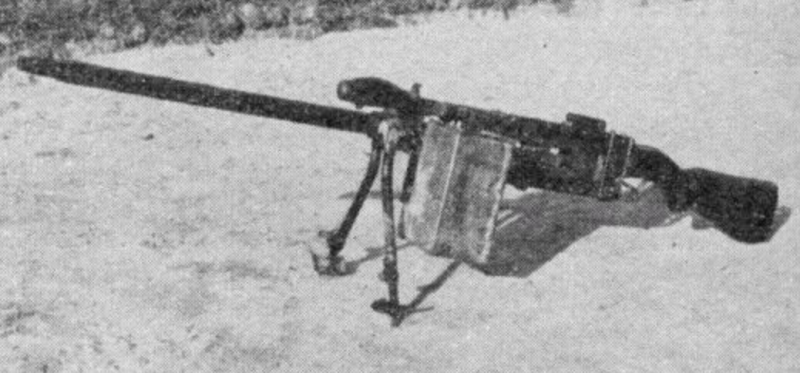
There was a concept in the US armed forces before and during World War II that a high rate of fire for weapons an infantryman is a disadvantage. High consumption of ammunition, rapid overheating of the barrel, increased wear of parts, etc. In the training films of the US Army of that period, which introduced soldiers to enemy weapons, it was directly stated: ours is less rapid-fire, which means it is better. The army even remade a couple of captured MG-42s for their own ammunition, and one of the requirements of the technical assignment was a multiple reduction in the rate of fire ... But more on that some other time.
At the same time, the Americans had a rifle-caliber machine gun with a very high rate of fire. Indeed, it was used in aviation. It was a Browning machine gun M2/AN (.30 caliber M2/AN). With the help of specialists from the Belgian FN Herstal, on the basis of a machine gun of the 1919 model, a rifle-caliber aircraft machine gun was created with a rate of fire of 1 rounds per minute (twice as high as that of its infantry counterpart).
The aviation browning had another interesting difference from the infantry version - it was much smaller in weight. The receiver was made of thinner metal, and the barrel was also lighter. The machine gun was almost a third lighter than the infantry М1919А4. The logic here was simple, cooling the barrel at altitude and at speed was not a problem, respectively, the barrel can be lightened, and the weight of the machine gun’s body is not needed to dampen the recoil, since the machine gun will still be mounted in the aircraft as a course or turret.
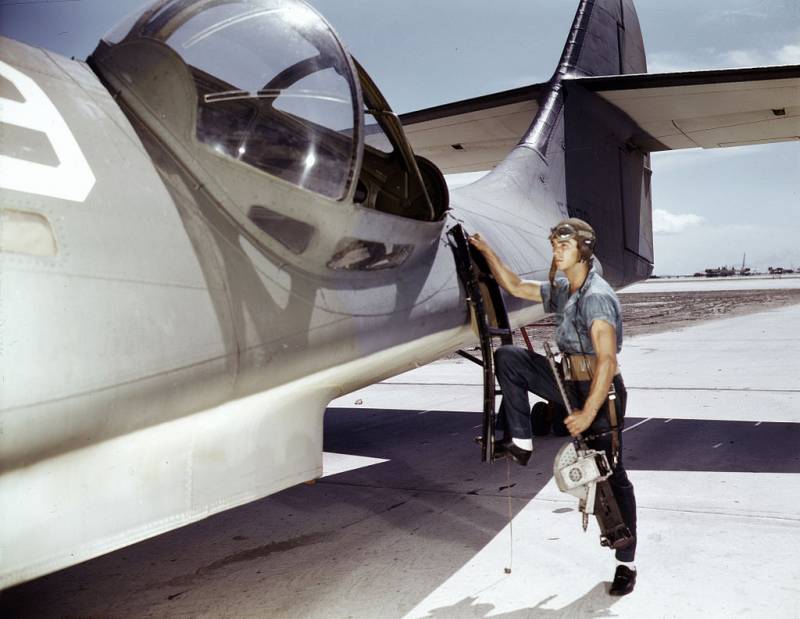
Canonical propaganda photograph of a Consolidated PBY Catalina flying boat crew member taken in 1942 at US Naval Station Corpus Christi. As we can see, the rifle-caliber M2/AN machine gun could be held even with one hand.
Although army aviation and aviation fleet they mainly used 50-caliber machine guns as forward on fighters and turrets on bombers, rifle-caliber machine guns were actively used throughout World War II as forward and turrets on dive bombers, reconnaissance aircraft, seaplanes, etc. That is, there were a lot of these machine guns , and they had a number of attractive characteristics.
Two plus two could not fail, it was only a matter of time when someone decides to use an aircraft machine gun in an infantry battle.
Milan Grevich
One of the first documented cases of this kind dates back to the fighting on Bougainville Island in 1943. We know about this thanks to the award documents of Private William Colby (Pvt. William Colby). He successfully repelled a Japanese attack using a rifle-caliber M2/AN machine gun mounted on an infantry mount.
At the same time, and around the same place, Sgt. Milan Grevich served and fought in the US Marine Corps. True, Grevich wanted a rapid-fire machine gun not as an easel machine gun, but a full-fledged rifle-caliber light machine gun with a high rate of fire.
The fact is that Grevich often went to the jungle as a patrol leader, and if he had to face the Japanese there, then there was a fleeting firefight. This is what much later, already during the period of American intervention in Vietnam, the Americans themselves will call the "seven-minute war." That is, a short-lived firefight in the jungle, where in a short period of time it is necessary to suppress the enemy with fire as much as possible, while the fire is often not aimed, since the enemy is simply not visible behind dense vegetation.
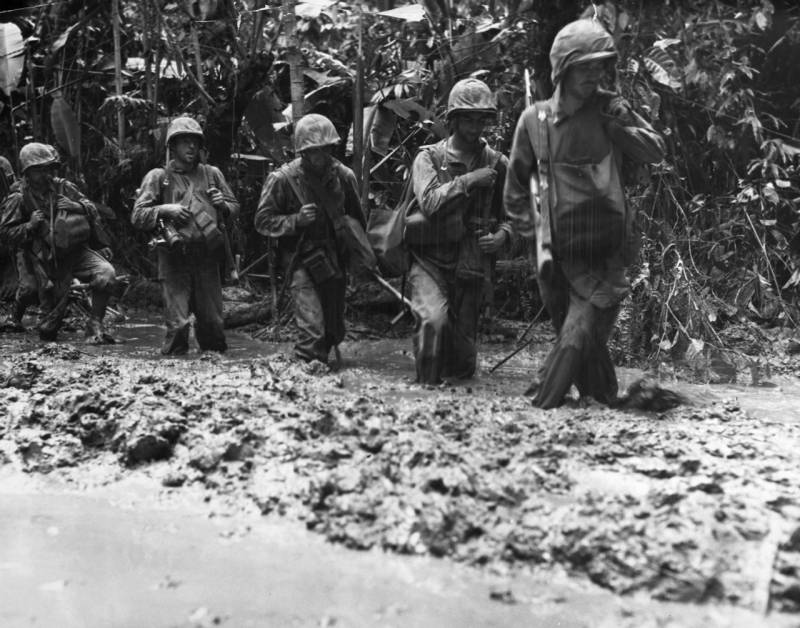
Marines' 60mm mortar crew floats along a trail on Bougainville Island, November 1943. Vegetation typical of the island is visible in the background.
And in the conditions of fire contact in the jungle, the Japanese, who had full-fledged light machine guns, could get some advantage. Yes, the Americans were head and shoulders above the Japanese in the number of self-loading and automatic weapons, but they did not have a full-fledged light machine gun. There was an automatic rifle, but the rate of fire was not the same, and a 20-round magazine. In 1943, hand-held firing of rifle-caliber Browning machine guns was already the standard shooting technique taught to machine gunners (thanks to John Basilone). But this is still feasible in an offensive in the infantry line, and the M1919A4 machine gun, in which only the body weighs 14 kilograms, you cannot carry with you on patrols.
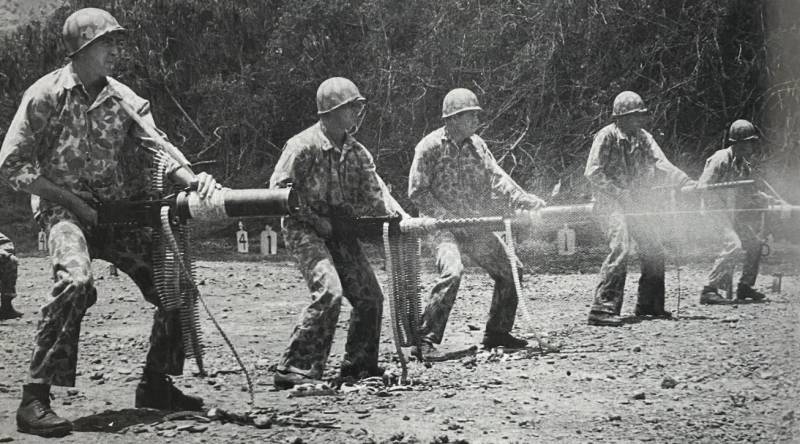
Marines practice firing rifle-caliber machine guns from the hip, 1943-1944. As we can see, in this way they taught to fire even from machine guns with a water-cooled barrel, М1917А1. Fabric machine-gun belts are used as improvised belts for carrying and holding weapons.
So Sergeant Grevich was seduced by the opportunity to get at his disposal a full-fledged light machine gun, light, with belt feed and a high rate of fire. Shortly in the jungle, it could be fired from the hip, and at a distance used as a full-fledged light machine gun. In his opinion, the aviation M2 / AN chambered for 7,62 × 63 mm (.30-06 Springfield) was quite suitable for this role, subject to some alterations. With this idea, he came to his commander ... And he got a turn from the gate. The command of the battalion only twisted a finger at his temple and decided that the sergeant had nothing to do, since his head was full of all sorts of nonsense. The idea of a rapid-fire light machine gun was rejected, and Sergeant Grevich continued to leave for the Bougainville jungle with what he had.
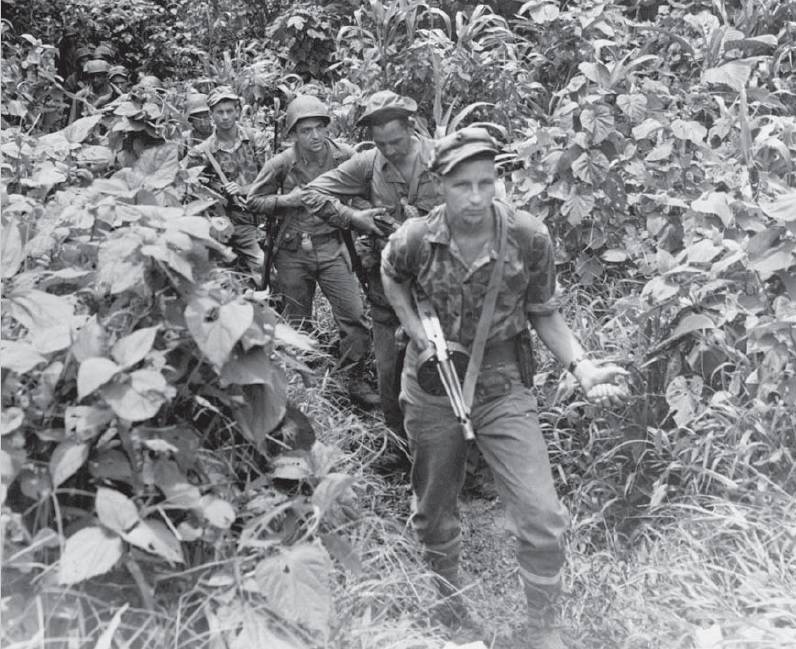
Staged shot of a Marine patrol in the jungles of New Britain, 1944. A grenade in hand, this is most likely a game for the camera, but the submachine gun of the Thompson M1928A1 system with a “tambourine” for 50 rounds from the patrol leader is just an objective reality. In the jungle it was possible in a fraction of a second to be nose to nose with the enemy, and it was necessary to be able to "land" the enemy a lot and quickly. But in conditions of dense vegetation, pistol ammunition was not always effective.
It was already 1944, Milan Grevich was assigned to a new unit and was part of the 5th division of the US Marine Corps on one of the Hawaiian Islands. The sergeant, who has not forgotten about his idea of a rapid-fire light machine gun, goes to the new command and sets out his conclusions. And receives support and complete carte blanche.
In Hawaii, there were many aviation units of the fleet, army aviation and marine aviation, aircraft fought without enemy opposition, weapons also constantly failed for one reason or another, in general, there was enough “building material”.
The idea was quite simple - an aircraft machine gun was taken, the trigger mechanism was altered, a butt with a part of the stock from the Garanda M1 rifle was fitted, sights were partially homemade, partially from the BAR automatic rifle, from the last bipod and a carrying handle, and voila - the light machine gun is ready.
How many fighters took part in the work and how long it took is not known for certain. But the work continued even when the division received a combat order and departed in the direction of its goal - the island of Iwo Jima. The last machine guns were completed on board the transports on the way to the landing target.
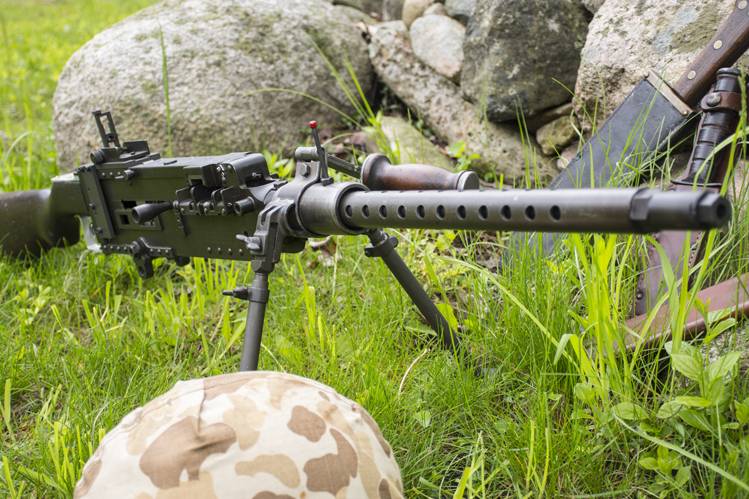
A modern replica of the work of Sergeant Milan Grevich. Not a single original machine gun has survived to this day. This particular example was made in Canada using the original M2/AN machine gun. "Still Life" is complemented by an M1 helmet with a camouflage cover, a USMC Mark 2 knife (in the common people - Ka-Bar) and a cleaver of the USMC Hospital Corps Knife medical staff (no, this is not for amputations, but more on that some other time).
A total of six machine guns were made. The creators gave their brainchild a formidable name - Stinger. Three were assigned to platoons in G Company, 28th Regiment, 5th Division. One machine gun went to the demolition unit of the 28th Regiment. One was personally used by Sergeant Grevich as a sergeant of the company's heavy weapons platoon. One machine gun went to the company "Alpha" (A company) of the same regiment.
Maybe story about six self-made machine guns and would be lost in the general outline of the history of the landing on the island of Iwo Jima. After all, it was a big battle, involving more than 100 members of the US armed forces. But the story of one of the machine guns designed by Sergeant Grevich received an unexpected continuation and great publicity.
Tony Stein
We are talking about a machine gun that ended up in Alpha Company, namely in the hands of Corporal Tony Stein (Cpl. Tony Stein). Why one machine gun ended up in another company is not known for certain. Perhaps Stein helped in the design and manufacture of machine guns. Or maybe the fact is that Stein and Grevich were old colleagues. Both of them were "paramarines" (paramarines) - fighters of the parachute battalions of the US Marine Corps. It was after the dissolution of the paramarine units that Stein and Grevich ended up in the 5th Marine Division.
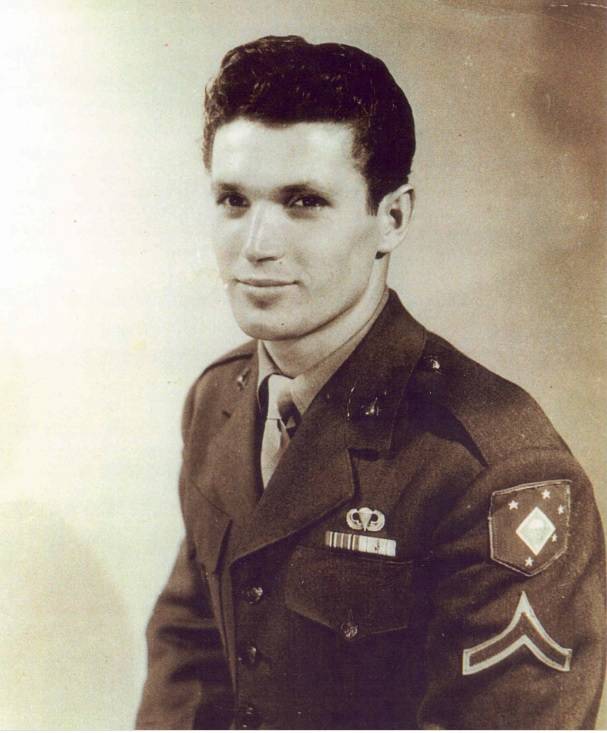
Photo of Tony Stein before he was promoted to corporal while serving in the USMC Paramarine Unit. A parachutist qualification badge is visible on the chest.
For his heroism during the Battle of Iwo Jima, Tony Stein was awarded the Medal of Honor. It was in the award documents that Stein's specific weapons were mentioned several times, namely: "home-made weapons of an aviation type" and "skillfully made home-made weapons."
We will not dwell on the feat itself, we can devote a separate article to this. Everything was there, Stein was the first to land on the shore, single-handedly attacked the bunker and suppressed it with machine-gun fire, eight times under enemy fire he returned to the company’s ammunition supply point for cartridges (the ammunition consumption of a rapid-fire machine gun is large, American military theorists were right), while each once taking out a wounded comrade from the battlefield, enemy bullets knocked the weapon out of his hands twice, but each time he picked it up and continued the battle, alone covered the retreat of one of the platoons under the onslaught of the enemy, etc. Unfortunately, on the tenth day of the battle Corporal Stein died for the island.
But the feat of Corporal Stein drew the attention of US Marine Corps officers to a machine gun designed by Sgt. Grevich. One of the machine guns went to the test.

Photo from the official test report of the Grevich machine gun. Judging by the surviving descriptions, almost all 6 machine guns differed slightly from each other in design, in particular in the location and design of sights. The photo clearly shows another feature that favorably distinguished an aircraft machine gun from an infantry machine gun, namely the ability to fix a box with a machine-gun belt on the side of the receiver.
Tests, in general, ended in nothing. The war is over, military budgets have been reduced dozens of times, many weapons projects have been shelved or simply forgotten. The idea of a rapid-fire belt-fed light machine gun was not continued either.
But the story of a stubborn sergeant who did not abandon his idea, and a heroic marine paratrooper who went into eternity with an unusual weapon in his hands, received publicity and will remain with us forever.
Information